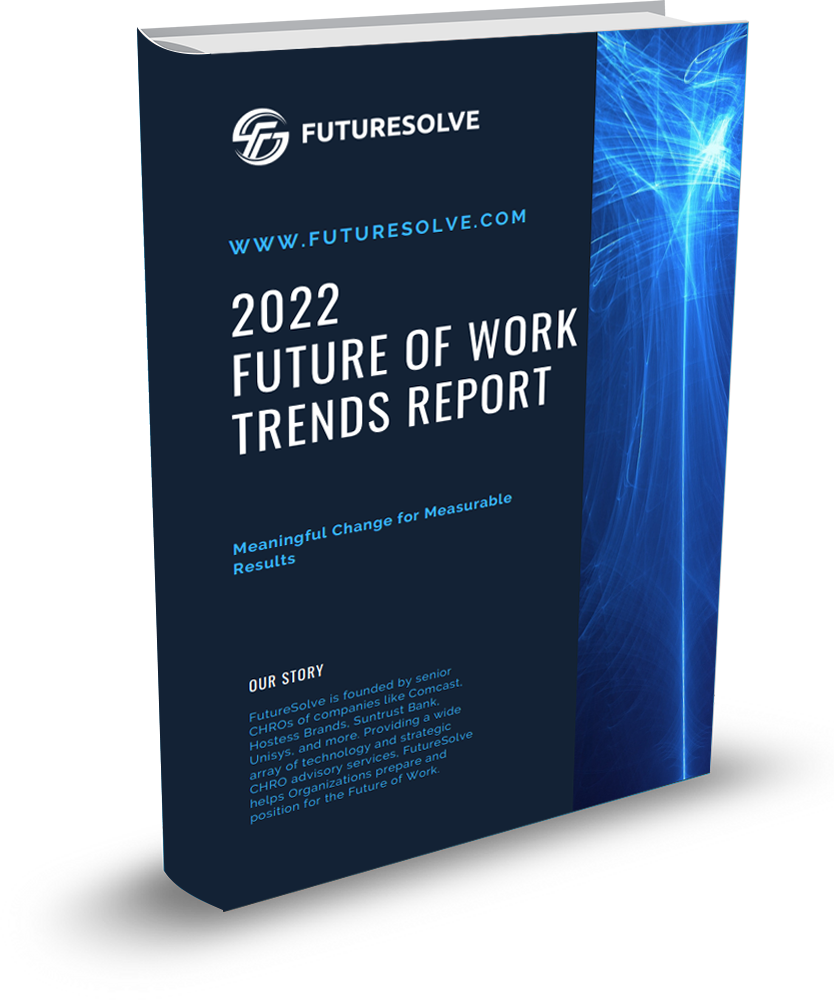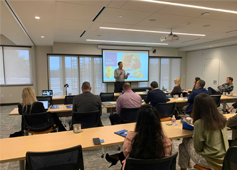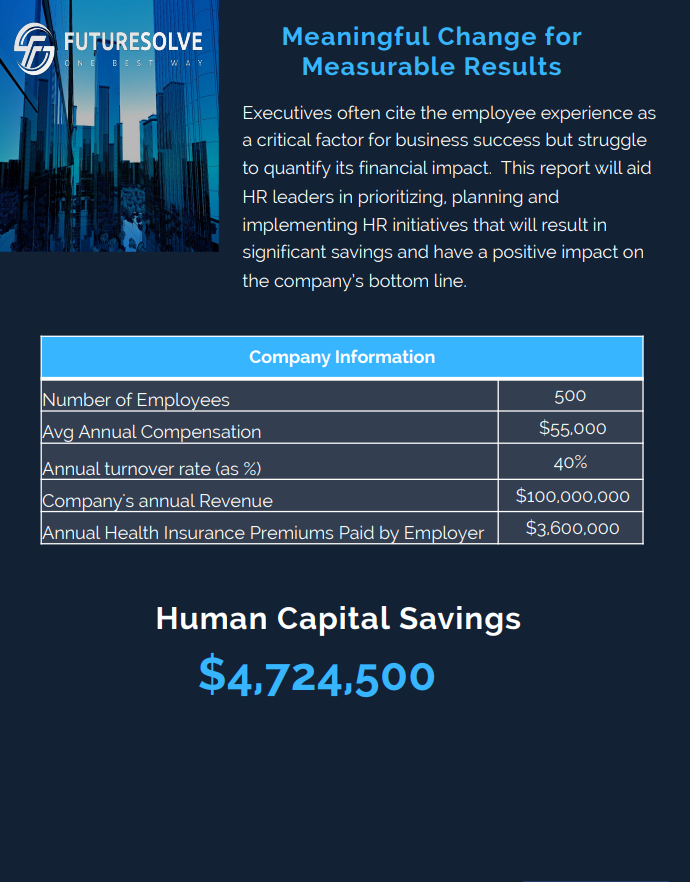2022 Future Of Work Trends Report


















































1
OPERATIONAL RESILIENCE
Resilience and sustainability go hand in hand. As all businesses gear up for another year, one thing that they cannot turn a blind eye to is sustainability. Their ultimate survival depends on how resilient they are and their ability to keep up future trends. Here are some factors that will help drive your company’s operational performance.
1. Leadership
Having a culture of trust is crucial at any company. The executive team needs to understand what good leadership looks like being authentic, trustworthy and one who invests in collaborative relationships across the organization. Growing and empowering capable leaders to rise up within the organization is the key to leadership success.
2. Accountability
Change is inevitable and at times, you have to rely on your employees to do certain tasks that they might not be prepared for. As a result, that reliance and mutual trust will push them to go above and beyond and drive overall performance. Performance measurement is a big trend where now with the hybrid work environment a strong way of measuring impact is key.
3. Diverse teams
Another driver of operational resistance is hiring individuals from different backgrounds and those that have diverse points of view. Developing diverse teams in your organization is crucial to improving sustainability performance.
3. Data analytics
Utilizing data from many different sources and using artificial intelligence to create predictive insights is a core component that will set you apart from other organizations who have not yet been able to make use of it. Access to different data sources will bring actionable insights.
4. Use of Technology at the Frontline We all know that frontline workers are the heartbeat of an organization. Thus, investing in frontline workers with a variety of technologies will equip them with what they need to further excel. It will help them be more efficient and upskill them towards new technology innovations.
5.Creating sustainable value
Focusing on creating sustainable value over time is a key factor for any successful company. Success lies in how much value you bring to people, processes, and products, and is crucial in impacting operational performance over a prolonged period of time.
6.Small changes equal big wins.
Like the one of our founders Dave Loeser & CHRO always says “Do Simple Better”. Focusing on the small areas that can be changed to make an impact creates an organization of change and small wins which ultimately will equal to a big win long term. This provides a focus on looking at what can you change now that will create a positive change and impact in the business.
7. Reducing environmental footprint As individuals become more and more aware of climate change and the environment, it is the organization’s duty to reduce or even eliminate their environmental impact. Innovative and forward-thinking businesses should look past the supply chain in order to improve sustainability across all business operations.
2
DIVERSIFYING THE LEADERSHIP BENCH (CORE DIVERSITY & INCLUSION THEMES IN WORKPLACE)
HR leaders are doing more than ever with leaders—awareness training, unconscious bias work, development. However, efforts are still seen as HR owned and not leadership owned. Transfer of accountability is critical to ensure diversifying the talent bench happens.
Women in Leadership Statistic—at end of 2020 after 4 decades of work on women in leadership, there were 7% female EU CEOs (up 5% over 2012) and 6% female US CEOs (up 3% since 2012). (Fortune 500 and S&P 500 companies)
People of Color Statistic— Racial and ethnic minorities made up 10% of CEO roles vs 5% in 2012 (Fortune 500 and S&P 500 companies)
Increasing demand for Diversity ,Equity & Inclusion from employees and shareowners
76% employees/job seekers say diverse workforce is important when valuing companies and job offers; 37% won’t apply to companies that have negative satisfaction amongst people of color.
Nearly half of S&P 100 companies are disclosing their diversity data publicly in 2021 from pressure from shareowners, institutional and activist investors, and their boards
Building a diverse talent pipeline is the focus of companies now (both global and US)
The core issue (cited by McKinsey study in 2018 & Gartner study 2021) indicates for the female pipeline that companies have good entry level pipelines for women; however, they are not sustaining them up the hierarchy of roles & responsibilities to the senior ranks. The experience is slower rates of promotion and lesser perception of leadership potential compared to male peers.
Frontline professional—56% women; 31% racial minorities
Mid-Sr Level leader—41% women;25% racial minorities
C-Suite leader—29% women; 17% racial minorities (source US Dept of Labor 2020 and Q1 2021)
Core Themes Impacting Building an Inclusive Pipeline (mainly owned by HR)
Bias Still Pervades Decision Making—though 80% of HR professionals say unconscious bias training is offered, there is a mismatch as the training is not linked to performance management and hiring/promotions; nearly 40% of senior leaders surveyed indicate they see their organizations have fair/unbiased performance management systems
Goals Set Without Specific Guidance—D, E & I goals need specific, measurable goals and set/owned by senior leadership, not HR. Over 80% companies surveyed have no ‘teeth’ for holding leaders accountable in their performance management systems for diversity initiatives.
Tracking DEI Metrics Creating Awareness, Not Necessarily Results—have to have individual, measurable, specific goals for leaders and ensure accountability for results, leadership agility, as well as the overall organization.
What is being done now?
Putting in place processes and systems that are objective and allow transparency/fairness/leadership models/tools/assessment & selection criteria that are objective and data driven, as well as holding leadership accountable.
Put metrics in place that are measurable that individual leaders can understand and be accountable for, vs organizational metrics that no one truly has accountability for.
Require stewardship of diversity & inclusion effort at the highest levels (C-Suite, Board) and steward the right metrics that matter that highlight progress/issues/gaps.
D, E I is a business imperative—it must be owned by the most senior leaders as part of the strategy and culture they want to create, and HR provides the leadership for process/tools/data.
Business Call to Action—by putting together the above, an organization can accelerate the diversity of the talent pipeline by 13 years. If not, the continued decline of progress will continue to increase. Is that okay for organizations to accept? If this was your customer or consumer speaking, the answer would be through their eyes a ‘resounding no.’
3
TALENT RISKS OF A POST COVID WORK ENVIRONMENT
Hybrid (digital) work model will be the future. 98% of HR leaders surveyed indicated they expect a hybrid model for future success. Even if for those employers who mandate a return to work policy, they will experience a hybrid model of working with customers, suppliers and networks, in a more digital way. Digital and virtual will become a mainstay in the way we manage our work life. For many it will be how and where we work, and for many it will involve also the way we work with others to accomplish our goals and thrive as a business.
60% employees interviewed want a hybrid work model of on site and work from home.
For those who have been totally remote during the pandemic, that number is 68%.
43% of employees want 2-4 days remote and the remainder for on site work. And, the meaning of working in a physical office has new significance— it must provide clear purpose and outcomes for those coming in (customer meetings, innovation, large team meetings, etc.).
Retention risks high—54% of employees indicated without flexible/hybrid work arrangements they will likely leave their employer.
Research shows that for those companies mandating a ‘hard return’ they could lose 1 out of 3 employees in the future.
73% of women who were on-site and went remote during the pandemic have indicated their expectations have increased for work flexibility if they are to be retained.
56% workers with disabilities have seen increased engagement and retention from a -hybrid work model and will be at risk in the future.
Companies Mandating a Hard Return.
Those mandating a hard return mainly indicate the need to reinforce the culture of their company and the uniqueness they bring to their employees.
However, 76% employees surveyed indicated flexible working arrangements benefit their cultures, not compromise it.
55% of employees are considered high performers when given the opportunity for flexible working arrangements, vs. 36% in a normal 9-5 physical working arrangement.
One important data point—leaders surveyed are more comfortable giving development opportunities/promotions to those employees on site.
Key Recommendations
Encourage leaders to move from ‘location centric’ to ‘human centric’ hybrid work strategy.
Identify the specific purpose and role of on site work requirements (front line manufacturing as example, or innovation ideation in work teams —not for answering your emails).
Create a best in class on site experience. Work with innovative tech/real estate to reconfigure workspace to allow for joint collaboration, cross functional work and activation, customer experiences, ideation, innovation. The old adage of ‘my office’ is gone —find ways and workplace trends to have communities of work where sharing, collaboration, innovation, creativity and learning are fostered and rewarded.
4
SUSTAINING CULTURE IN POST COVID WORK ENVIRONMENT
Employees surveyed have higher cultural satisfaction working remote or in a hybrid work arrangement vs with no flexibility and indicate that company culture has had a higher impact (+) on their job.
For those reporting a higher impact of company culture, they indicated a 2.4X Increase in engagement, 2.7X higher effort and intent to stay; 3.5X higher inclusion.
66% of leaders surveyed indicated their success is highly dependent upon autonomy and control (and physical on site management is the way to do that).
What can be done to reinforce right culture:
Ensure leaders are aware of what values/behaviors are necessary to reinforce and/or change and role model those (if you want more inclusive decision making you have to delegate and allow autonomy of decision making with your employees, as example). Physical office presence does not define culture—behaviors do.
The concept of top down driven culture is shifting —it is more bottom up through the lens of the individual employee and what is important to them. Continuous listening sessions and pulse surveys are critical to understand what is important to your employees, and ensure the cultural values/behaviors match what resonates with them. Top down mandates are shifting to ‘what works best for me in my family, my neighborhood, my community’. The new community is not the physical office location any longer.
Embed those cultural behaviors inside of operational work processes—budgets, decision making, empowerment, innovation, etc. And communicate what those cultural values/behaviors are and what they look like when done well. Integration of these values/behaviors need to be linked to the way and how people work, such that the employees see culture as ‘real’.
Make sure that the audio and the video match. If leaders espouse behaviors but act the opposite, there will be a disconnect with employees and lack of belief that these values matter or are important.
Reward leaders/managers for role modeling the right behaviors. Reward employees for the same. Recognition of the shifts people are making is key —learning sessions, open dialogue discussions, frequent and different channels of communication, are key.
SUMMARY
FUTURE OF WORK REINVENTED
COVID has shattered antiquated assumptions about work. What work we do, where we do it, how we do it, when we do it and why we do it. Leaders have a huge opportunity to break away from a ‘location-centric’ work model designed in with industrial area restraints, to redesign work in a ‘human-centric’ model to secure digital- era talent and achieve business outcomes.
Key Findings
Pandemic has uncovered old, archaic assumptions about work and the world is begging for reinvention.
The world has reached a critical juncture in the evolution of work—the normalization of remote work has reset expectations of a hybrid work model.
Many leaders fear that by not going back to the old world of working on site it will risk achieving business outcomes—the data suggests the opposite. That employees can thrive and excel in performance, contribution, and impact to business success far greater than the old way of working.
There are huge human capital risks involved if flexibility, adaptability and change is not seen in the work environment. The highest risk is for women and minorities and can further impact a company’s efforts to improve diversity and inclusion.
The enabler to success is by learning and experimentation, asking for employee feedback, frequent communication in a variety of channels. Also, assignment of work should be deliberately tied to the company’s talent strategy and can be a great way to demonstrate equity and fairness in the assignment of work, developmental learning opportunities, high visibility, project assignments, etc. Moving to a more ‘human-centric’ model implies more experimentation, trying things differently, becoming more innovative, and involving your employees in the solution. It can also serve as a strong engagement tool to retain the talent you wish to retain.
Those employees surveyed indicated up to 40% willing to leave if required to work in the old model of work. Other external surveys the number is more than 60%. Clearly the redesign of work, job assignments, location, project team assignments, development opportunities—all of this will become strategically more important.
The research shows that business outcomes will be improved—more resilience of the organization to deliver performance; more responsiveness and innovation in responding to customer and consumer needs; higher levels of individual performance due to more flexibility for
employees, which drives discretionary effort and better business mentoring performance; and lower cost to run the business through reduced real estate and operational costs, as well as lowering their carbon footprint.
Call 469-229-7958 to speak to an Advisor. Email info@futuresolve.com for any inquiries. Visit www.FutureSolve.com for more information.
More Resources


Case Studies


Events


Blogs


News


Leadership Videos


